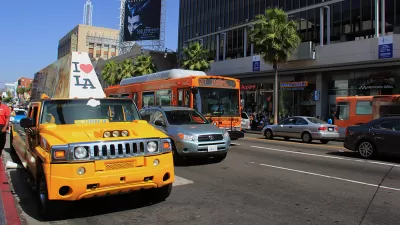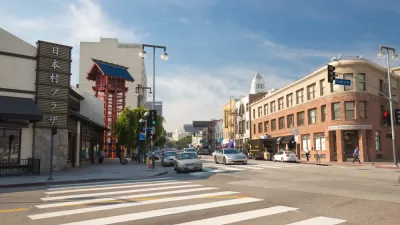The Los Angeles City Council voted to officially end the use of Level of Service in measuring environmental impact in favor of a more people-friendly measure: vehicle miles traveled.

Joe Linton reports from Lo Angeles, where the City Council recently approved a substantial change to environmental review in accordance with the California Environmental Quality Act (CEQA).
Linton describes the consequences of choosing LOS as the primary measure of a development project's impact:
LOS is a way of measuring traffic, though it perniciously and simplistically only measures car traffic, and doesn’t even do that meaningfully. Measuring for LOS shows any project that increases car congestion – such as building new housing – as adversely impacting the environment. To supposedly fix congestion – the adverse environmental impact of that new housing – LOS measurements end up requiring more space for cars, so a housing project might also have to widen the road. LOS incorrectly assumes that car traffic is a static quantity, denying the effects of induced travel. LOS said that the 405 Freeway would be less congested after it was widened. That didn’t happen.
The change from LOS to VMT was mandated by SB 743, a law approved by the state of California in 2013. Several cities in the state have already made the switch, including Pasadena and San Francisco. Outside of the state, Seattle is also working on reforming its use of Level of Service as a measure of development impact mitigation.
For more details on the effort by the city of Los Angeles to replace LOS analysis with VMT, see also a post by Steven Sharp from February 2019.
FULL STORY: Big Wonky Good News: L.A. City Adopts People-Centered Transportation Metric: “VMT” In, “LOS” Out

Alabama: Trump Terminates Settlements for Black Communities Harmed By Raw Sewage
Trump deemed the landmark civil rights agreement “illegal DEI and environmental justice policy.”

Planetizen Federal Action Tracker
A weekly monitor of how Trump’s orders and actions are impacting planners and planning in America.

The 120 Year Old Tiny Home Villages That Sheltered San Francisco’s Earthquake Refugees
More than a century ago, San Francisco mobilized to house thousands of residents displaced by the 1906 earthquake. Could their strategy offer a model for the present?

Ken Jennings Launches Transit Web Series
The Jeopardy champ wants you to ride public transit.

BLM To Rescind Public Lands Rule
The change will downgrade conservation, once again putting federal land at risk for mining and other extractive uses.

Indy Neighborhood Group Builds Temporary Multi-Use Path
Community members, aided in part by funding from the city, repurposed a vehicle lane to create a protected bike and pedestrian path for the summer season.
Urban Design for Planners 1: Software Tools
This six-course series explores essential urban design concepts using open source software and equips planners with the tools they need to participate fully in the urban design process.
Planning for Universal Design
Learn the tools for implementing Universal Design in planning regulations.
Clanton & Associates, Inc.
Jessamine County Fiscal Court
Institute for Housing and Urban Development Studies (IHS)
City of Grandview
Harvard GSD Executive Education
Toledo-Lucas County Plan Commissions
Salt Lake City
NYU Wagner Graduate School of Public Service




























